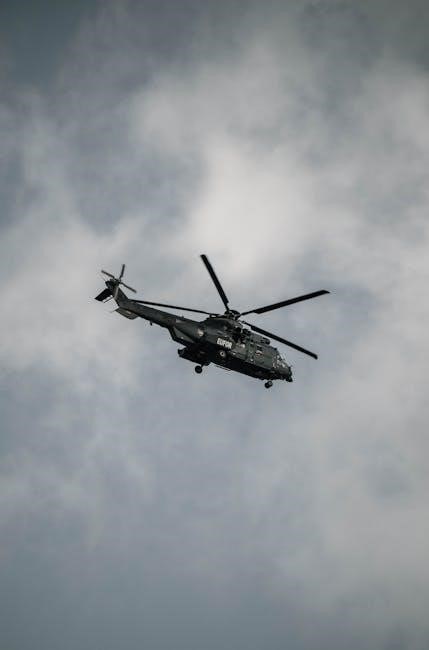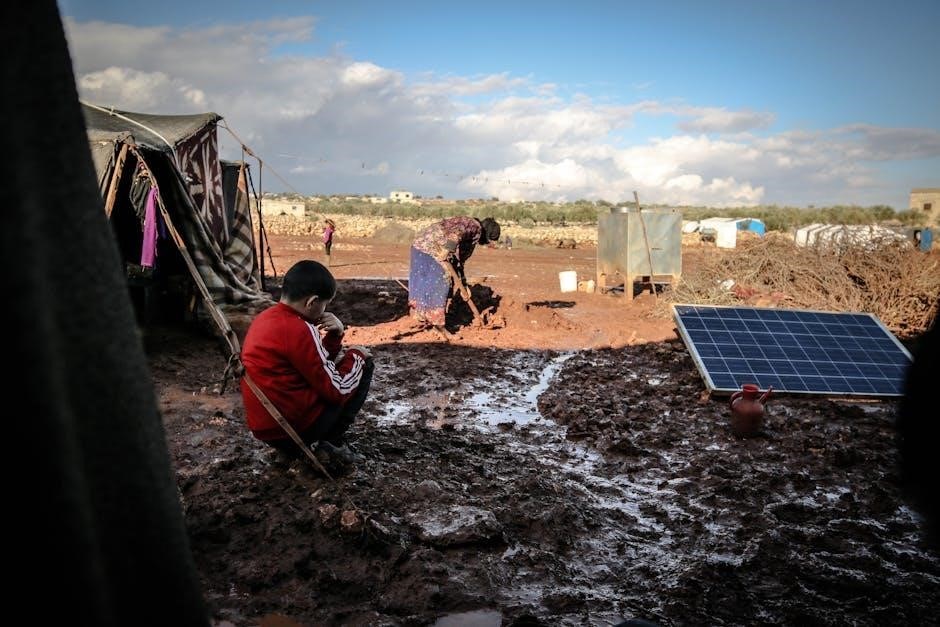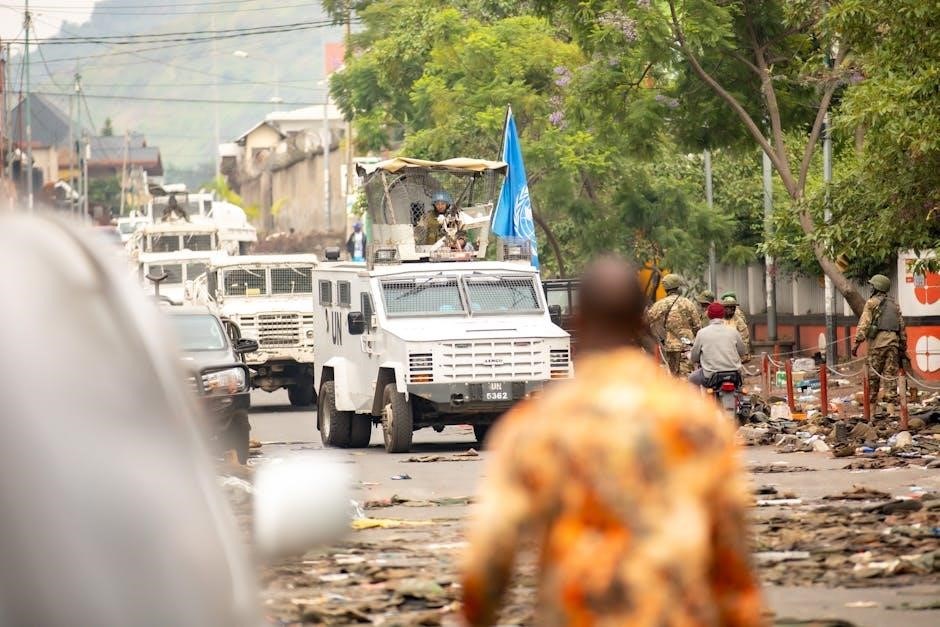Kim Jong Un has been a pivotal figure in advancing North Korea’s nuclear ambitions, emphasizing self-reliance and deterrence. Under his leadership, the Byungjin policy prioritizes simultaneous economic and nuclear development, solidifying the program’s role in national security and global diplomacy.
Overview of North Korea’s Nuclear Ambitions
North Korea’s nuclear ambitions are driven by a strategic goal of ensuring national security and sovereignty. The program is central to the regime’s survival, with Kim Jong Un repeatedly emphasizing the necessity of nuclear deterrence to counter external threats. The Byungjin policy, introduced under Kim’s leadership, underscores the dual pursuit of economic development and nuclear advancement, reflecting the regime’s commitment to both modernization and military strength. The nuclear program is not merely a defensive measure but also a tool for political leverage, enabling Pyongyang to negotiate from a position of power on the global stage. North Korea’s nuclear aspirations are further fueled by historical grievances and a deep-seated mistrust of external powers, particularly the United States. The regime has consistently demonstrated its resolve to expand its nuclear capabilities, despite international condemnation and economic sanctions. This unwavering commitment highlights the program’s significance as a cornerstone of North Korea’s national identity and strategic vision.
Kim Jong Un’s Role in Nuclear Development

Kim Jong Un has played a central role in advancing North Korea’s nuclear program, personally overseeing key developments and tests. Since assuming power, he has prioritized nuclear modernization, emphasizing the importance of miniaturizing warheads and enhancing delivery systems. His leadership has been marked by a series of high-profile missile and nuclear tests, showcasing the regime’s technological progress. Kim has repeatedly stated that nuclear weapons are essential for national defense and sovereignty, framing them as a deterrent against external threats. His public statements and directives have consistently reinforced the program’s strategic importance, ensuring its continuation despite international sanctions. Under his guidance, North Korea has also focused on producing enriched uranium, a critical component for nuclear warheads, and has made strides in tactical nuclear capabilities. Kim’s direct involvement in military drills and inspections underscores his personal commitment to maintaining and expanding the country’s nuclear arsenal. His leadership has solidified North Korea’s status as a nuclear power, shaping both regional security dynamics and global diplomatic efforts.

Background of North Korea’s Nuclear Program
North Korea’s nuclear ambitions trace back to the Cold War era, with the program accelerating in the 1980s. The country joined the NPT in 1985 but withdrew in 2003, pursuing nuclear weapons despite global opposition, marking a defining shift in its secretive nuclear agenda.
Origins of North Korea’s Nuclear Aspirations
North Korea’s nuclear aspirations originated during the Cold War, driven by geopolitical instability and the desire for self-reliance. The program gained momentum in the 1980s, with the construction of nuclear facilities at Yongbyon. The country’s withdrawal from the Non-Proliferation Treaty in 2003 marked a significant escalation, solidifying its commitment to nuclear development despite international sanctions and condemnation. Kim Jong Un has since emphasized the importance of nuclear weapons for national security and deterrence.
Historical Milestones in Nuclear Development
North Korea’s nuclear program has been marked by several pivotal milestones. The 1994 Agreed Framework aimed to freeze nuclear activities in exchange for aid, but its collapse in 2002 led to accelerated development. In 2006, North Korea conducted its first nuclear test, drawing global condemnation. By 2011, under Kim Jong Un’s leadership, the program expanded rapidly. The 2017 test of the Hwasong-14 ICBM demonstrated a capability to reach the United States, escalating tensions. The 2018 Singapore Summit with the U.S. hinted at denuclearization talks but yielded little progress. Recent advancements include the 2021 revelation of miniaturized nuclear warheads and tactical weapons, showcasing technological leaps. These milestones underscore North Korea’s commitment to nuclear deterrence, despite crippling sanctions and diplomatic isolation.

Kim Jong Un’s Policies and Statements on Nuclear Weapons
Kim Jong Un has consistently emphasized the importance of nuclear weapons for national defense and deterrence. He has publicly stated that North Korea will not relinquish its nuclear arsenal and will continue to strengthen its capabilities under the Byungjin policy.

Key Statements by Kim Jong Un on Nuclear Deterrence
Kim Jong Un has repeatedly emphasized the importance of nuclear weapons as a vital deterrent against external threats. He has stated that North Korea will not hesitate to use its nuclear arsenal if its sovereignty is threatened, particularly by the United States or its allies. In numerous speeches, he has highlighted the need to bolster the country’s nuclear capabilities to ensure national security and regional stability. Jong Un has also underscored the modernization of North Korea’s nuclear forces, including the development of tactical nuclear weapons and improved delivery systems. He has warned that any attempt to infringe upon North Korea’s sovereignty or territorial integrity would result in a preemptive nuclear response. His statements reflect a clear commitment to maintaining and enhancing the country’s nuclear deterrent, which he views as essential for survival in a hostile geopolitical environment. These declarations have consistently been echoed in state media, reinforcing Pyongyang’s unwavering stance on nuclear deterrence.
Kim Jong Un’s rhetoric has also targeted South Korea and the United States, with specific threats to use nuclear weapons if attacked. He has criticized military exercises between Seoul and Washington, labeling them as provocations that justify North Korea’s nuclear posture. Additionally, he has dismissed calls for denuclearization, asserting that North Korea’s nuclear program is irreversible and non-negotiable. His statements have been consistent with the broader strategy of leveraging nuclear weapons as both a defensive and diplomatic tool, ensuring North Korea’s position in international relations.
The Byungjin Policy: Simultaneous Economic and Nuclear Development
The Byungjin Policy, introduced under Kim Jong Un’s leadership, represents a dual strategy of advancing both economic development and nuclear weapons capabilities simultaneously. This policy reflects a significant shift from previous regimes, which often prioritized one sector over the other. By pursuing both goals, North Korea aims to ensure national security through nuclear deterrence while laying the groundwork for long-term economic sustainability. The policy emphasizes self-reliance, with Kim Jong Un repeatedly stressing the need to reduce dependence on external factors.
The implementation of the Byungjin Policy has involved allocating significant resources to both sectors, with nuclear development receiving particular attention. Kim Jong Un has framed this approach as essential for safeguarding the nation against external threats while building a prosperous society. Critics argue that this dual focus strains the economy, but the regime maintains that it is necessary for survival in a hostile international environment. The policy has also been used to justify continued nuclear testing and weapons modernization, despite global condemnation. Overall, the Byungjin Policy underscores Kim Jong Un’s vision of a secure and prosperous North Korea, where nuclear capabilities and economic growth are seen as complementary rather than conflicting goals.

North Korea’s Nuclear Capabilities
North Korea’s nuclear arsenal is estimated to include 20-50 warheads, with growing capabilities in uranium enrichment and missile technology. The regime has developed long-range ICBMs, posing a direct threat to distant targets, and continues to expand its nuclear production infrastructure.
Current Estimates of North Korea’s Nuclear Arsenal
Current estimates suggest that North Korea possesses between 20 to 50 nuclear warheads, with the potential to expand this number significantly. The regime has demonstrated advancements in uranium enrichment facilities and plutonium production, enabling the creation of more sophisticated nuclear devices. Recent reports indicate that North Korea may be producing miniaturized nuclear warheads, enhancing their tactical capabilities. Additionally, the country has developed long-range intercontinental ballistic missiles (ICBMs) capable of delivering nuclear payloads to distant targets, including the United States. Experts warn that North Korea’s nuclear arsenal could grow to 400-50 warheads in the near future, posing a grave threat to regional and global security. The regime’s ability to enrich uranium and develop advanced missile systems underscores its commitment to expanding its nuclear deterrent. These developments have raised concerns among international observers, as they signify a growing nuclear threat with potential implications for global stability and non-proliferation efforts.
Types of Nuclear Weapons and Delivery Systems
North Korea’s nuclear arsenal includes a variety of weapons and delivery systems, designed to enhance its deterrence capabilities. The regime has developed tactical nuclear weapons, capable of targeting regional adversaries, as well as strategic weapons for long-range deterrence. Recent advancements include miniaturized nuclear warheads, which can be mounted on ballistic missiles. The Hwasong-14 and Hwasong-15 intercontinental ballistic missiles (ICBMs) are key components of North Korea’s strategic nuclear forces, with the potential to reach the United States. Additionally, the Hwasong-12 intermediate-range ballistic missile (IRBM) can strike targets in Japan and Guam. North Korea has also tested submarine-launched ballistic missiles (SLBMs), such as the Pukguksong-3, which could provide a second-strike capability. Furthermore, the regime has developed strategic cruise missiles, which can carry nuclear payloads and evade missile defense systems. These advancements underscore North Korea’s efforts to diversify its nuclear delivery systems, ensuring a multi-layered deterrent against potential threats. The combination of miniaturized warheads and advanced missiles significantly enhances the regime’s ability to project nuclear power regionally and globally.

International Reactions and Diplomatic Efforts
The international community has condemned North Korea’s nuclear advancements, with the U.S., South Korea, and Japan strengthening military alliances. China advocates for diplomacy, while the U.N. imposes sanctions. Despite global efforts, negotiations have stalled, leaving the nuclear issue unresolved.
United States’ Stance on North Korea’s Nuclear Program
The United States has consistently maintained a firm opposition to North Korea’s nuclear program, viewing it as a direct threat to regional and global security. Under various administrations, the U.S. has pursued a dual-track approach, combining diplomatic efforts with economic sanctions. The U.S. has emphasized the importance of denuclearization as a prerequisite for any meaningful negotiations, often in collaboration with allies like South Korea and Japan. Despite occasional summits and talks, including the historic meeting between former President Donald Trump and Kim Jong Un, progress has been limited. The U.S. has also increased its military presence in the region, deploying strategic assets to deter North Korean aggression. Sanctions imposed by the U.S. and its allies aim to cripple North Korea’s economy, hoping to pressure the regime into abandoning its nuclear ambitions. However, North Korea has shown resilience, continuing to develop its nuclear arsenal despite international pressure.
South Korea and Japan’s Responses to the Threat
South Korea and Japan have been at the forefront of addressing the North Korean nuclear threat, with both nations adopting a mix of military and diplomatic strategies. South Korea has strengthened its military alliance with the United States, conducting joint exercises and deploying advanced missile defense systems like THAAD. President Yoon Suk-yeol has emphasized the need for a strong deterrence posture, while also exploring diplomatic channels to engage Pyongyang. Japan, similarly, has bolstered its defense capabilities, including the development of long-range missile systems, and has worked closely with the U.S. and South Korea to coordinate a unified response. Both nations have consistently supported international sanctions against North Korea and have called for denuclearization through dialogue. However, their approaches have also faced challenges, with public opinion in both countries expressing concerns about the escalating tensions and the potential for conflict. The two nations remain committed to regional stability, balancing deterrence with diplomatic efforts to address the North Korean nuclear issue.
China’s Role in North Korea’s Nuclear Diplomacy
China has maintained a complex yet crucial role in North Korea’s nuclear diplomacy, balancing its responsibilities as a permanent member of the UN Security Council with its historical alliance with Pyongyang. Beijing has consistently advocated for a denuclearized Korean Peninsula and has supported UN sanctions against North Korea, while also providing economic and political support to the regime. China’s position is driven by its strategic interests, including preventing regional instability and countering U.S. influence in East Asia. Chinese leaders have mediated in multilateral talks, such as the Six-Party Talks, aiming to find a peaceful resolution to the nuclear standoff. However, China’s effectiveness in influencing North Korea has been questioned, as Pyongyang has often defied international pressure. Despite this, China remains a key player in the diplomatic efforts, emphasizing dialogue over confrontation to address the nuclear issue. Its dual approach reflects the delicate balance it seeks to maintain between upholding global nonproliferation norms and safeguarding its geopolitical interests in the region.
International Sanctions and Their Impact
International sanctions imposed on North Korea have significantly impacted its economy and global relations. The UN Security Council, alongside individual countries, has enforced strict measures targeting North Korea’s nuclear and missile programs. These sanctions have debilitated key sectors, including coal exports, seafood, and textiles, which are crucial for the regime’s revenue. The restrictions have also limited access to luxury goods and advanced technology, further isolating Pyongyang. Despite these measures, North Korea has demonstrated resilience, relying on illicit activities and clandestine networks to circumvent sanctions. The economic strain has, however, exacerbated internal challenges, with reports indicating widespread hardship among the population. While sanctions aim to pressure North Korea into denuclearization, their effectiveness remains debated. The regime has responded by strengthening its nuclear resolve, viewing the program as a vital deterrent against external threats. The interplay between sanctions and North Korea’s nuclear development highlights the complex dynamics of global efforts to curb its ambitions. The long-term impact of these measures on the regime’s stability and nuclear trajectory remains uncertain.

Military Demonstrations and Tests
North Korea has conducted numerous missile and nuclear tests, showcasing its military capabilities. Tests like the April 5 long-range missile over Japan and the May 25 underground nuclear test drew global condemnation, underscoring Pyongyang’s advancing arsenal and deterrence strategy.
Notable Missile Tests and Their Implications
North Korea’s missile tests have been a cornerstone of its military demonstrations, showcasing advancing capabilities and drawing global attention. The 2017 test of the Hwasong-14 ICBM marked a significant milestone, demonstrating potential to reach the U.S. mainland. Similarly, the Hwasong-15, tested later that year, further solidified North Korea’s long-range strike capacity. These tests underscored the regime’s commitment to deterrence and self-defense, aligning with Kim Jong Un’s strategic goals. The 2024 tests of strategic cruise missiles, supervised by Kim, highlighted readiness to deploy nuclear attack capabilities. Such demonstrations not only elevate regional tensions but also provoke international condemnation and stricter sanctions. The tests have consistently defied U.N. resolutions, reinforcing North Korea’s reputation as a rogue state. Each missile launch serves as a reminder of Pyongyang’s advancing arsenal and its intent to modernize military capabilities, deepening concerns among neighboring nations and the global community about the escalating nuclear threat. These actions have also spurred stronger military alliances and defense postures among the U.S., South Korea, and Japan, intensifying the geopolitical stakes in the region.

Nuclear Tests and Global Condemnation
North Korea’s nuclear tests have consistently drawn widespread international condemnation, escalating global tensions. The 2013 test, Pyongyang’s third, demonstrated a miniaturized nuclear device, while the 2016 test claimed to be of a hydrogen bomb, sparking fears of enhanced destructive power. The 2017 test, the sixth and most powerful at the time, triggered a 6.3-magnitude earthquake and heightened regional anxieties. These tests have been met with unified criticism from the United Nations Security Council, leading to stricter sanctions. The 2025 underground nuclear test and subsequent missile launch over Japan intensified global outrage, prompting emergency meetings at the U.N. and calls for denuclearization. Such actions have solidified North Korea’s reputation as a rogue state, deepening its isolation. Despite condemnation, Kim Jong Un has emphasized that these tests are essential for national security and deterrence, signaling no intention to cease. The international community remains alarmed, viewing each test as a direct threat to global stability and non-proliferation efforts, further complicating diplomatic relations and heightening military preparedness in the region.

Future Prospects and Concerns
North Korea’s nuclear program poses significant future concerns, with Kim Jong Un vowing to expand the arsenal. The potential for further modernization and proliferation raises global security risks, while international diplomacy struggles to address the escalating threat.
Will North Korea Denuclearize?
North Korea’s willingness to denuclearize remains uncertain, with Kim Jong Un repeatedly emphasizing the importance of nuclear weapons for national security. Despite international pressure, Pyongyang has shown no indication of abandoning its arsenal, viewing it as a deterrence against external threats. Kim Jong Un has consistently stated that nuclear weapons are non-negotiable, especially after witnessing the fate of Libya’s Muammar Gaddafi, who dismantled his weapons program. Experts believe that denuclearization would require significant concessions and security guarantees, which the international community has yet to offer. North Korea’s Byungjin policy, prioritizing both economic and nuclear development, further solidifies its commitment to maintaining a nuclear deterrent. Recent statements by Kim Jong Un and his sister, Kim Yo Jong, have dismissed the idea of denuclearization talks, calling them a “mockery.” With North Korea’s nuclear program advancing, the likelihood of voluntary denuclearization appears increasingly remote, raising concerns about regional stability and global security.
Moreover, North Korea’s recent military demonstrations and nuclear tests underscore its resolve to expand, not reduce, its nuclear capabilities. The international community, including the United States, South Korea, and China, faces a daunting challenge in addressing this issue. Sanctions and diplomatic efforts have had limited impact, and without a fundamental shift in North Korea’s strategy, the prospects for denuclearization remain bleak. As tensions rise, the world watches closely, hoping for a peaceful resolution to this critical issue.
Expert Predictions on the Program’s Future
Experts predict that North Korea’s nuclear program will continue to expand under Kim Jong Un’s leadership, with a focus on enhancing both the quantity and quality of its arsenal. Many analysts believe that Pyongyang aims to develop smaller, more tactical nuclear weapons, as hinted by Kim Jong Un in 2021. This miniaturization could enable North Korea to deploy nuclear weapons on a variety of platforms, increasing its military flexibility. Additionally, the regime is expected to refine its delivery systems, including ballistic missiles, to improve accuracy and range.
The Byungjin policy, which prioritizes simultaneous economic and nuclear development, suggests that North Korea will not abandon its nuclear ambitions. Experts warn that the program could grow more sophisticated, potentially leading to exponential increases in the number of warheads, currently estimated to be between 40 and 50. The involvement of key figures, such as Kim Yo Jong, underscores the regime’s resolve to maintain and expand its nuclear capabilities.
Overall, the international community faces a challenging outlook, as North Korea’s nuclear program shows no signs of slowing down, raising significant concerns for regional and global security.
Potential Impact on Global Security
The expansion of North Korea’s nuclear program under Kim Jong Un poses significant risks to global security. A growing arsenal increases the likelihood of nuclear proliferation, potentially destabilizing the region and beyond. The development of tactical nuclear weapons and advanced delivery systems raises concerns about miscalculations or unintended escalation.
North Korea’s nuclear tests and missile launches have already heightened tensions with neighboring countries, prompting military build-ups and strengthening alliances. This could lead to an arms race in East Asia, further complicating geopolitical dynamics. Additionally, Pyongyang’s defiance of international sanctions and treaties undermines global non-proliferation efforts, setting a dangerous precedent for other nations.
The potential for North Korea to share nuclear technology or materials with other states or non-state actors remains a critical concern. This could exacerbate existing conflicts and create new security challenges worldwide. As Kim Jong Un continues to prioritize nuclear development, the international community faces an increasingly volatile landscape, necessitating urgent diplomatic and strategic responses to mitigate these risks.


